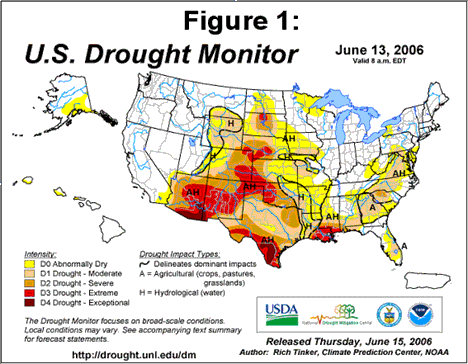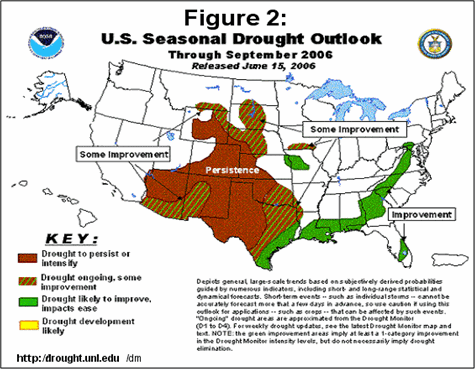AG-ECO NEWS
Vol. 22, Issue 20, June 21, 2006
Jose G. Peña
Extension Economist-Management
Dry Winter-Spring is Over; Start Planning Fall ‘06 and Spring ‘07
While parts of Texas received some rain this past week, the passing of the summer solstice on June 21 indicated that spring is over and dry, hot summer weather is here. While concentrated rain along the Gulf Coast caused flooding in Houston and flood watches in the region east of San Antonio, most of Texas remains very dry. (See Figure1). The rain helped settle dust which, along with high dry winds, was starting to form dust storms. But, for the most part, the rain was not sufficient to provide a significant boost to agricultural production.

With spring over, we should focus on this summer’s crop harvest and drought associated problems, reduce livestock stocking rates further, initiate plans to safeguard wildlife, plan for potential fall ‘06 production alternatives and start planning for 2007.
The southwest Texas region has generally only received about 25 percent of the long term year-to-date average rainfall. As measured in Uvalde, Texas, the October 13-to-date period is the driest in over 100 years of records with only about 3.2 inches of rain, compared to a long term average of about 15.3 inches for the same period. The moisture situation is critical and weathermen are not optimistic about the outlook for rain this summer, through September ‘06. (See Figure 2).

Aflatoxin
Drought stress, especially in corn, is causing serious concerns for the potential of aflatoxin contamination this summer. Aflatoxins are the unfortunate poisonous by-products of some very common fungi. These Fungi are very common in our daily lives. We routinely breathe the spores produced by fungi, mostly without any ill effect.
According to Dr. Mark Black, Extension Plant Pathologist, certain strains of the Aspergillus flavus fungus produce aflatoxins. This fungus can take advantage of corn under stress. Drought and heat stress, during and after pollination, rainfall as harvest approaches, and high moisture conditions during storage favor Aspergillus flavus fungus contamination. It is almost impossible to control the organism since it survives long term in corn cobs, crop debris and in the soil. When hot weather arrives, multitudes of wind-blown spores are released.
In terms of coping with aflatoxin problems in the future, USDA-ARS scientists are developing a potential solution. Peter Cotty, USDA-ARS, plant pathologist, found that some Aspergillus flavus strains do not produce aflatoxin. If these “safe” strains are introduced to a plant, they will prevent the poisonous strains from developing. The Environmental Protection Agency (EPA) has labeled a safe strain, Aspergillus flavus 36, as a safe strain for farmers to apply. Dr. Cotty is promoting heavy inoculation of fields with this “safe” strain one year prior to planting corn, preferably to a cotton rotation crop. By inoculating a year in advance, the “safe” fungus has time to colonize crop debris and be ready to produce multitudes of “safe” spores in the second year, when corn is planted in that field.
Livestock/wildlife
While the market for calves, feeders and lambs remains very attractive, some may want to retain their breeding livestock. However, this dry spell may require further stocking adjustments. Wildlife resource use is rapidly becoming the economic basis of the ranching industry in Southwest Texas. A drought management plan should prioritize wildlife management, to the extent that it is economically feasible. Further reducing livestock stocking rates may help protect remaining wildlife since both may complete for the same resources. Under conditions of feed shortage, livestock feed more heavily on browse, which normally sustains deer throughout the year. Providing supplemental nutrition in specially designed wildlife feeders will help sustain wildlife during this difficult period. Fortunately mast production should help wildlife. Trees, such as mesquites, under stress produced extra amount of seed pods, called masting, as nature provides genetic survival mechanisms in plants.
Water is no doubt the most important of all nutrients for all living things, but especially for wildlife and livestock. Since ruminants, such as cattle and deer, are able to store large amounts of water in their stomachs, they are better adapted in surviving droughts than monogastrics, such as hogs. The absence of drinking water may force a livestock liquidation decision. Wildlife are more mobile and will travel great distances to water. When movement is restricted by high fences, however, special water arrangements should be considered to protect wildlife.
